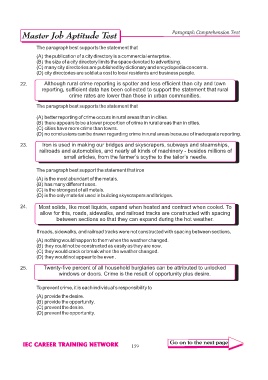Page 169 - GMAT 2017b_Neatb
P. 169
Paragraph Comprehension Test
The paragraph best supports the statement that
(A) the publication of a city directory is a commercial enterprise.
(B) the size of a city directory limits the space devoted to advertising.
(C) many city directories are published by dictionary and encyclopedia concerns.
(D) city directories are sold at a cost to local residents and business people.
22. Although rural crime reporting is spotter and less efficient than city and town
reporting, sufficient data has been collected to support the statement that rural
crime rates are lower than those in urban communities.
The paragraph best supports the statement that
(A) better reporting of crime occurs in rural areas than in cities.
(B) there appears to be a lower proportion of crime in rural areas than in cities.
(C) cities have more crime than towns.
(D) no conclusions can be drawn regarding crime in rural areas because of inadequate reporting.
23. Iron is used in making our bridges and skyscrapers, subways and steamships,
railroads and automobiles, and nearly all kinds of machinery - besides millions of
small articles, from the farmer’s scythe to the tailor’s needle.
The paragraph best support the statement that iron
(A) is the most abundant of the metals.
(B) has many different uses.
(C) is the strongest of all metals.
(D) is the only material used in building skyscrapers and bridges.
24. Most solids, like most liquids, expand when heated and contract when cooled. To
allow for this, roads, sidewalks, and railroad tracks are constructed with spacing
between sections so that they can expand during the hot weather.
If roads, sidewalks, and railroad tracks were not constructed with spacing between sections,
(A) nothing would happen to them when the weather changed.
(B) they could not be constructed as easily as they are now.
(C) they would crack or break when the weather changed.
(D) they would not appear to be even.
25. Twenty-five percent of all household burglaries can be attributed to unlocked
windows or doors. Crime is the result of opportunity plus desire.
To prevent crime, it is each individual’s responsibility to
(A) provide the desire.
(B) provide the opportunity.
(C) prevent the desire.
(D) prevent the opportunity.
159

